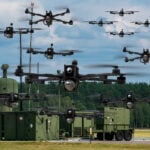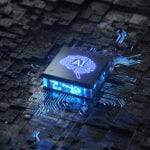AI and The Great Workforce Skill Set Shift

Table of Contents
Whether AI and the technologies it enables will reach their full potential depends on the workforce that will work alongside them. Yet the skills that that workforce needs to do this are in short supply. Rather than debating what to do about massive job losses from AI, discussion should focus on how best to prepare workers’ skills for the types of jobs that they will need to fill.
A shifting job picture
A 2017 McKinsey’s report[i] says that approximately half of all activities done by the current workforce could be automated. They point out, however, that this does not point to massive job losses as much as it does to the workforce needing to shift their skill sets to fit new needs that transformed business processes require.
This pronouncement is borne out by studies in Germany,[ii] where automation in manufacturing has progressed far faster than in the U.S. These studies showed no lower employment level from automation. Rather, they showed a shift in entry level jobs from the manufacturing sector to the service sector. It is true that they also showed stagnation or even reduction in wages for those who remained in manufacturing, but this is not an argument for abandoning automation – rather, it underscores the need for workers to enhance their skill sets if they want to thrive in an AI-enabled workplace.
Another study[iii] showed that manufacturing companies that moved toward automation did not greatly reduce their employee base. They largely replaced production jobs by investing in new jobs in sales and marketing.
One example of technology changes leading to redeployment of those whose jobs the technology replaces is in the adoption of ATMs by banks[iv] over the past three decades. If any technology seemed poised to kill an entire job category, ATMs fit the description. While the average number of tellers per branch decreased from 20 to 13 between 1988 and 2004, increased automation brought down the cost of operating a branch. It also enabled banks to redeploy personnel into more sales-oriented functions. This reduction in cost and increase in revenues enabled banks to open 43% more branches. As a result, banks were able to employ far more people, including more tellers.
A word of caution
This doesn’t mean, though, that we should expect disruptions of the job market to work themselves out seamlessly, as in the organic view of AI’s future. There are more variables to consider.
AI is capable of sweeping across the entire workforce with fewer adaptations needed for each industry to adopt it than past technological revolutions have needed. And the abilities it gives for early adopters to build insurmountable competitive advantages over late adopters may compress the gradual adoption rates of past technological disruptions, creating a much shorter period for the transition to new job categories to occur. If this is the case, disruption to workers could be significant, even if job transitions even out in the long term. In the Introduction to this book, we described the enclosures that transformed agriculture in England during the First Industrial Revolution. No effort was made to retrain the displaced agricultural workers – they were left to sink or swim and many sank. Avoiding that catastrophe this time around is within our control.
And that leads us to the personal aspect of AI’s disruption. It’s one thing to look at situations from a high-level vantage point and see the employment numbers for a technological shift showing no net job loss. It’s another thing to look at that technological shift from the perspective of someone whose skill set has been deemed expendable. For that person, the net job loss numbers are 100%. And if they lack skills that are needed in the transformed workforce, their job hunt may be lengthy.
We looked, in the previous chapter, at how creativity had recognized gaps created by new technologies in the information dissemination industry over the centuries and how many million of jobs had been created. Yet that glowing description of job gains in the industry would be of little solace to someone whose skills fit only the rapidly shrinking print newspaper or periodical industries, and who is finding his or her job options dwindling. Within living memory, compositors were a highly paid workforce segment in newspaper publishing. In some Western countries, they exercised a degree of control over what their newspapers could print and when they could print it. They were paid considerably more than the journalists whose words they set in print. There are very few compositors today.
Stability in employment figures are not all that matters as we approach AI’s advance. The livelihoods of individuals working in industries that AI will transform must be considered if AI is indeed going to have a positive effect on our world.
A Gartner study[v] predicts that one-third of technology jobs will go unfilled by 2020 because of a shortage of talent. That is an alarming figure. Workers will have to shift their skill sets to fill the needs of the reshaped market. Yet that issue is often overlooked in discussions of AI. A 2017 McKinsey report[vi] touches on this:
“While much of the current debate about automation has focused on the potential for mass unemployment, people will need to continue working alongside machines to produce the growth in per capita GDP to which countries around the world aspire. Thus, our productivity estimates assume that people displaced by automation will find other employment. Many workers will have to change, and we expect business processes to be transformed. … [T]he total productivity gains we estimate will only come about if people work alongside machines. That in turn will fundamentally alter the workplace, requiring a new degree of cooperation between workers and technology.”
“Workers will have to change.” “Business processes [will] be transformed.” Productivity gains will come only with a fundamental skill set shift that is rarely being discussed in the back-and-forth about massive job losses versus Universal Basic Income versus a magical smooth transition into an AI-enabled society.
The AI need for new skill sets
Equipping the existing workforce with the skills that will be needed for an AI-enabled world is critical to its successful transformation. Shifting worker skill sets to more high-value tasks will require workers to enhance their skill sets to keep up with the technology. A World Economic Forum report[vii] states:
“[T]echnological disruptions such as robotics and machine learning – rather than completely replacing existing occupations and job categories – are likely to substitute specific tasks previously carried out as part of these jobs, freeing workers up to focus on new tasks and leading to rapidly changing core skill sets in these occupations. Even those jobs that are less directly affected by technological change and have a largely stable employment outlook – say, marketing or supply chain professionals targeting a new demographic in an emerging market – may require very different skill sets just a few years from now as the ecosystems within which they operate change.
On average, by 2020, more than a third of the desired core skill sets of most occupations will be comprised of skills that are not yet considered crucial to the job today. …
For example, the Mobility industries expect employment growth accompanied by a situation where nearly 40% of the skills required by key jobs in the industry are not yet part of the core skill set of these functions today.”
A McKinsey study of projected skill shifts between 2016 and 2030[viii] focused on five skill categories:
- Physical/manual skills, such as operating vehicles, moving materials, packaging or cleaning
- Basic cognitive skills, such as the literacy and arithmetic needed for data entry
- Higher cognitive skills, such as creativity, critical thinking, decision-making and complex information processing
- Social/emotional skills, such empathy, persuasion, leadership, entrepreneurship, initiative and managing others
- Technological skills, namely, understanding technologies and how to adapt them
The study projected drops of 14-15% in the need for physical/manual skills and basic cognitive skills, while showing an 8% increase in demand for higher cognitive skills, 24% for social/emotional skills and a massive 55% for technological skills.
Emerging jobs in an AI-enabled world
The most obvious skill set shifts will be in jobs directly related to AI. A Microsoft whitepaper, The Future Computed,[ix] gives examples of the technological skill sets that will be needed as routine work is replaced by either automation or AI:
“New jobs will emerge as AI changes how work is done and what people need from the world around them. Many of these jobs will be in technology. For example, banks will need network engineers instead of tellers. Retailers will need people with web programming skills to create online shopping experiences instead of greeters or salespeople on the floor. Farms will need agricultural data analysts instead of fruit pickers. Demand for data scientists, robotics experts and AI engineers will increase significantly.”
A 2016 KPMG report[x] pictures some others:
“If you’re building and maintaining robots for transaction processing and repetitive tasks, you need people with strong analytical skills who understand how to translate business rules into logic statements. While a programming background is not required, it does help shorten the learning curve of the new technology and ultimately decreases the payback period for the investment.
On the other hand, if you are pursuing robots for cognitive technology, you need people with deep subject matter expertise to provide the robot’s initial knowledge base, validate that knowledge base over time, and respond to cases when the robot does not know the answer. You will also need people who can codify the robots’ knowledge base, which may require some technical expertise depending on the product.
Either kind of robot will require people to set up and maintain the technology’s infrastructure, identify opportunities for adoption throughout the business, and mitigate risks.”
The PwC report[xi] mentioned in the previous chapter also identifies some AI-related jobs that likely will emerge to meet AI’s ever-expanding needs:
“In addition to new types of workers who will focus on thinking creatively about how AI can be developed and applied, a new set of personnel will be required to build, maintain, operate, and regulate these emerging technologies.”
With the nearly 300 new use cases[xii] that PwC has identified in its sector-specific reports, we can expect that AI-related jobs will be so plentiful that they will likely be hard to fill with qualified candidates.
More subtle shifts
Not all skill sets will be directly related to AI. We previously saw how the introduction of ATMs enabled banks not only to redeploy existing tellers into higher-value sales and service functions, but also to drive expansion through the higher-value work they were doing, resulting in increased profits. Although this will not happen with all workers whose work is rendered redundant by new technologies, it should happen with those who already possess some of the skills needed in positions into which they are redeployed.
Similarly, we previously saw how AI would likely replace much of the manual administrative work that geoscientists currently do, even as the demand for more geoscientists is likely to increase significantly. That suggests that AI will not replace geoscientists, but merely give them more opportunity to practice their specialized skills and pursue deeper specializations that help drive further profits for their industries.
Many other occupations will likely see the same scenario. Rather than AI and other emerging technologies replacing those who have highly specialized skills, those technologies likely will replace only specific tasks of those jobs. This will enable those workers to focus on more high-value tasks, as occurred with bank tellers.
New job categories
We are also likely to see new job categories emerge as currently unforeseen implications of AI become evident. We can see a hint of this in one new job category that has risen from nonexistent to common in the past 20 years: privacy lawyer.
Growing concerns about the use of consumer information in the 1990s led to the development of privacy laws to govern that use. This, in turn, spurred the growth of specialists in these laws. In 1997, the International Association of Privacy Professionals (IAPP) was formed to support this fledgling occupation. As of early 2018, the organization boasted a membership of more than 20,000 specialists in privacy law,[xiii] who help corporations navigate the rapidly growing body of laws developing in more than 100 countries that have privacy regulators.
How might this repeat itself with AI? One possibility is some sort of ethics specialists among coders. Facebook’s 2017 experiments with chatbots programmed to negotiate deals with humans had chilling results. Although the bots were not intentionally programmed to do so, as they interacted with humans and learned from them, they developed a tendency to lie[xiv] in order to achieve their assigned goals. Thus, a possible issue in the development of AI will be to ensure that machine learning as bots interact with humans does not lead to the bots learning – and carrying out – the negative behaviors that it observes in humans.
Add to that the likelihood that AI will lead to a whole body of laws that govern its use, just as happened with privacy law. That suggests that specialists in AI law will emerge, as well. In addition to such specialists, a new class of law enforcement specialists will likely emerge, just as specialists in cybercrime emerged to combat the misuse of the internet for criminal endeavors.
So, too, is the likelihood that, in addition to coders, a type of AI specialist will develop that focuses on overseeing AI systems to ensure that they adhere to established standards designed to protect those affected by them. This would be a separate entity from the law enforcement specialists. Law enforcement specialists would focus on intentional efforts to harm others through AI. Oversight specialists would function more like the boards that currently oversee the practice of doctors or lawyers to ensure that AI practitioners maintain the standards expected of them in their practice.
Expect the unexpected
We should also expect that not all job shifts spurred by AI will be predictable. Brad Smith and Harry Shum, in their foreword to Microsoft’s The Future Computed[xv] use the following analogy of the rise of the automobile to show the unrelated – and unexpected – effects it had on society:
“The transition to cars initially contributed to an agricultural depression that affected the entire American economy in the 1920s and 1930s. Why? Because as the horse population declined rapidly, so did the fortunes of American farmers. In the preceding decade, roughly a quarter of agricultural output had been used to feed horses. But fewer horses meant less demand for hay, so farmers shifted to other crops, flooding the market and depressing agricultural prices more broadly. This agricultural depression impacted local banks in rural areas, and then this rippled across the entire financial system.
Other indirect effects had a positive economic impact as the sale of automobiles led to the expansion of industry sectors that at first glance appear disconnected from cars. One example was a new industry to provide consumer credit. Henry Ford’s invention of the assembly line made cars affordable to a great many families, but cars were still expensive, and people needed to borrow money to pay for them. As one historian noted, “installment credit and the automobile were both cause and consequence of each other’s success.” In short, a new financial services market took flight.
Few, if any, people foresaw these shifts as automobiles were introduced. Perhaps some could have predicted a downturn in the manufacture of horse-drawn carriages, but the effect on farmers and rural economies and the development of a new financial industry to support the automotive industry would likely have eluded most prognosticators of the time.
So, too, we can expect that some industries that have no obvious connection to AI will falter as AI grows. Similarly, new, unimagined industries will develop. In other words, we must expect the unexpected and be agile enough to move with the flow of surprises that AI brings.
Hardest hit will be those whose eggs, so to speak, are in one basket tied to their present job. Those who diversify their skill sets with understanding of emerging technologies will be prepared to move in the direction where workers will be in demand if contraction occurs in their present field. Specialized skills supporting digital capabilities such as robotics, augmented reality computations, cybersecurity and data science in particular will be in demand.”
New problems to solve
We should also expect AI’s effect to be more far-reaching than early testing would lead many to believe. For example, it’s one thing to have a single autonomous vehicle on the road responding to the actions of human drivers. But what would it be like if all the cars on a rush hour freeway were autonomous? What would determine which vehicle gets to move into an open space in a faster-moving lane when two vehicles simultaneously determine that that space will help them reach their destinations sooner?
The situation potentially could be like that if a busy airport counted on pilots to land their planes safely without benefit of air traffic controllers. With autonomous vehicles on freeways, though, the number of vehicles competing for space is far greater in both numbers and desired destinations. Will some form of traffic controllers be needed to sort things out? Such issues are yet to be addressed and could result in new job categories.
Such issues are already arising, as in the case of the Uber car that killed a cyclist[xvi] during a test of its autonomous features in Tempe, Arizona, in March of 2018. An investigation showed no problems in the vehicle’s hardware and software; it simply had been set to ignore readings that it interpreted as false positives in the interest of maintaining a smoother ride. Even with a human backup driver in place, the vehicle ignored the cyclist and plowed into her at full speed before the backup driver realized what was happening.
This underscores the continued need for human involvement in AI. In fact, we have seen evidences of the need for the human touch throughout this chapter. Look back and you’ll see the need for people throughout the discussion of AI-enabled jobs. Here are just a few that were mentioned:
- People to create online shopping experiences
- People who understand how to translate business rules into logic statements
- People with deep subject matter expertise to provide the robot’s initial knowledge base
- People to find creative new ways to use AI
- People to build, maintain and operate AI
- People to regulate the use of AI
As you look at that list, only two of those mentioned are strictly technological skills – people who understand how to translate business rules into logic statements; and people to build, maintain and operate AI. And the former is not totally technological, because it also requires critical thinking and creativity.
AI’s need for the human touch
Ironically, many of the skill sets needed to keep up with the technology are not technological skills. Instead, they are distinctly human ones. Whereas machines shine when it comes to situations that call for data and rules, they come nowhere close to matching humans when it comes to social skills, emotional intelligence, persuasion, collaboration or – perhaps most important of all – creativity.
We saw this clearly in the ATM example. Rather than replacing humans, the technology enabled banks to redeploy humans into jobs that required a distinctly human touch – sales, customer service, collaboration.
It also empowered the explosion of new products and services that banks launched during that time. It enabled banks to deploy more personnel not only to selling and servicing these offerings, but also to envisioning and developing them.
For all the capabilities that AI has been trumpeted as having, it is incapable of determining how best to use its own capabilities. It can mimic human creativity, but it cannot move beyond what humans have equipped it to learn. In other words, humans remain essential to the process of determining how to use AI to best advantage. The World Economic Forum report[xvii] puts it this way:
“Overall, social skills – such as persuasion, emotional intelligence and teaching others – will be in higher demand across industries than narrow technical skills, such as programming or equipment operation and control. In essence, technical skills will need to be supplemented with strong social and collaboration skills.”
Takeaways and AI and skills
As AI and other emerging technologies become increasingly integrated into our lives, many existing job categories will be rendered redundant. At the same time, new job categories that require new skills will emerge. Some will be technical in nature, but the most important skills will be distinctly human ones.
We, as leaders need to prepare for massive changes in the way things have always been done. And we need to prepare our organizations’ workforce – and ourselves – with the skills needed to navigate the changes that are already starting to affect our organizations.
[i] James Manyika, Michael Chui, Mehdi Miremadi, Jacques Bughin, Katy George, Paul Willmott and Martin Dewhurst, Harnessing Automation for a Future that Works, McKinsey Global Institute, 2017, Available: https://www.mckinsey.com/global-themes/digital-disruption/harnessing-automation-for-a-future-that-works
[ii] Jill Petzinger, Germany has way more industrial robots than the US, but they haven’t caused job losses, 2017, Available: https://www.weforum.org/agenda/2017/10/germany-has-way-more-industrial-robots-than-the-us-but-they-haven-t-caused-job-losses
[iii] Kristin Houser, Is Technology Really Going to Destroy More Jobs Than Ever Before?, Futurism.com, 2017, Available: https://futurism.com/technology-destroy-jobs/
[iv] Michael Morganstern, Automation and Anxiety, The Economist, 2016, Available: http://www.economist.com/news/special-report/21700758-will-smarter-machines-cause-mass-unemployment-automation-and-anxiety
[v] Vikram Bhalla, Susanne Dyrchs and Rainier Strach, Twelve Forces That Will Radically Change How Organizations Work, The New New Way of Working Series, BCG, 2017, Available: https://www.bcg.com/en-us/publications/2017/people-organization-strategy-twelve-forces-radically-change-organizations-work.aspx
[vi] Manyika, et al, Ibid.
[vii] The Future of Jobs: Employment, Skills and Workforce Strategy for the Fourth Industrial Revolution, World Economic Forum, 2016, Available: https://www.weforum.org/reports/the-future-of-jobs
[viii] Jacques Bughin, Eric Hazan, Susan Lund, Peter Dahlström, Anna Wiesinger, and Amresh Subramaniam, Skill shift: Automation and the future of the workforce, McKinsey, 2018, Available: https://www.mckinsey.com/featured-insights/future-of-organizations-and-work/skill-shift-automation-and-the-future-of-the-workforce
[ix] The Future Computed, p.101, Microsoft, 2018, Available: https://news.microsoft.com/futurecomputed/
[x] Employees: An Endangered Species?, KPMG, 2016, p. 11, Available: https://assets.kpmg.com/content/dam/kpmg/pdf/2016/04/employees-an-endangered-species.pdf
[xi] Sizing the prize: What’s the real value of AI for your business and how can you capitalise?, 2017,, p. 6, Available: https://www.pwc.com/gx/en/issues/data-and-analytics/publications/artificial-intelligence-study.html
[xii] Sizing the prize, p. 10
[xiii] Brad Smith and Harry Shum, The Future Computed, Forward, p.9, Microsoft, 2018, Available: https://news.microsoft.com/futurecomputed/
[xiv] Kevin Maney, How Facebook’s AI Bots Learned Their Own Language and How to Lie, Newsweek, 2017, Available: http://www.newsweek.com/2017/08/18/ai-facebook-artificial-intelligence-machine-learning-robots-robotics-646944.html
[xv] Smith and Shum, Ibid, p.13.
[xvi] Rhett, Jones, Report: Uber’s Self-Driving Car Sensors Ignored Cyclist In Fatal Accident, Gizmodo, 2018, Available: https://gizmodo.com/report-ubers-self-driving-car-sensors-ignored-cyclist-1825832504
[xvii] The Future of Jobs, Ibid.
For 30+ years, I've been committed to protecting people, businesses, and the environment from the physical harm caused by cyber-kinetic threats, blending cybersecurity strategies and resilience and safety measures. Lately, my worries have grown due to the rapid, complex advancements in Artificial Intelligence (AI). Having observed AI's progression for two decades and penned a book on its future, I see it as a unique and escalating threat, especially when applied to military systems, disinformation, or integrated into critical infrastructure like 5G networks or smart grids. More about me, and about Defence.AI.











































